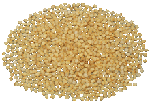RADISH, DAIKON, TURNIP
JAPANESE RADISH
Another names:
- Green radish Raphanus Sativus L. convar lobo
- Brassicaceae (Crucifers)
Green radish is one of garden radish,variety. As daikon it came to Ukraine from Japan and as daikon it is more popular than garden radish (bitter radish). Radish roots are rich in vitamins of B and PP groups, ascorbic acid, carotene and amino acids. Great value has its content of carbohydrate, mineral salt, nitrogenous matter, cellulose, essential oil ( less than in bitter radish), different biological substances, ferments. Roots can be consumed as fresh, salted, you can add leaves of young radish to salads. Roots of green radish are firm, juicy, mid-flavor. Storage qualities of green-radish are better than daikon. Roots can be round and longish and have different colour such as light-green, dark-green, pink-red and lilac-violet. Radish gives an appetite, activate laxation. Thanks to that fact that green radish almost hasn't glycosides and mustard oil that make fruit bitter and flavor, old people can consume it without having problems with heart or liver.
GARDEN RADISH
- Garden, bitter radish (Raphanus sativus)
- Brassicaceae (Crucifers)
Radish was started to grow more that 5 thousand years ago in Ancient Egypt, Babylon, Ancient Greece and Rome. It was brought to Rus in 12 centuary where it became irriplaceable vegetable. Nowadays it spreads in all countries of the world. In Ukraine it is grown in an open ground. Radish-roots rich in vitamins of group B and PP, ascorbic acids, carotene, amino acids. Carbohydrates, mineral and nitrous agents, cellulose, different biological agents and ferments are very valuable part of radish. It takes one of the main place among vegetables for containing mineral salt (kalium, natrium, phosphorus, iron). Radish-roots also contain glycosides that exudes essential oil and gives radish specific aroma, flavor and pleasant bitterness. Radish-roots can be consumed as fresh, boiled or salted; young leaves and sprouts can be added to salads.
DAIKON
Another names:
- Sweet radish, Japanese radish Raphanus sativus subsp. Acanthiformis
- Brassicaceae (Crucifers)
This variety was discovered in Japan from Chinese radish (oriental radish). It is very popular in Japan, it takes first place at acreage among other vegetables, it is in everyday menu of the Japanese. It is also grown in Southeast Asia, USA, Brazil and in Western Europe. It is more popular than garden radish (bitter). Daikon roots can be consumed as fresh, salted or boiled. Young leaves and sprouts are the main source of B-Carotene, vitamins C, B1, B2, PP, K, protein and other biologically active agents. Large white root with juicy, crispy flesh looks like carrot. It is daikon. The name of this vegetable can be translated as “a big root”. Today some varieties of this crop can be in a length of 60 cm and in diameter it is 10 cm. This radish earns first places among vegetables thanks to its excellent eating qualities and health-giving power. Daikon has a lot of names such as white radish, white root, Japanese radish, sweet radish. Dietarians recommend to eat this vegetable at least once per week. 100 g of its flesh contains 40% daily demand of C vitamin, 8% of folacin, 4% of copper and magnesium. It also contains minerals such as kalium, iron, calcium, phosphorus, iode, selenium, chrome, it is rich in B-carotene, vitamins of B group, vitamins D, E, K, cellulose and pectin. When you chose daikon in the supermarkets pay great attention to its shape, weigh, fruit should be heavyweight, smooth without cracks. Rots that are bigger in diameter than 5 cm have better sweet taste. Thin young roots (less than 3 cm in diameter) have flat taste and old roots usually have very hot taste. It is also possible to eat seeds sprouts, and young leaves for salads. Daikon can be consumed not just as fresh but also boiled, fried, marinade you can add it to salads and soups. It is long-day plant, but there is varieties that can strongly react on the day duration or don't react at all. The highest yield is in autumn harvesting by sowing in the end of June or in the beginning of July. The latest sowing can be in the beginning of August, but radish-roots won't be so big.
GARDEN OR SALAD TURNIP
Another names:
- Garden turnip,
- Salad turnip,
- Leaf turnip,
- Brasica rapa,
- Brassicaceae (Crucifers)
Turnip - is an old vegetable, that has a long 4 thousands history. It was very popular in Ancient Egypt, Rome, Greece as grain crops and grape. In Ukraine before appearance of potato turnip and baga were main crops. Cultivated turnip came from wild-turnip. The most variable it was in Western Europe and Asia. Turnip is popular in Japan, India, USA. In Ukraine it is grown at a small holding in all regions. Turnip contains a lot of kalium and iron, very important vitamins C, PP, B1, B2, provitamin A and uncommon for plants succinic acid. Roots contain 9% of saccharose, 0,2 % of mustard oil that give specific aroma and taste. Dry basis include 1,74 % of proteins, 0,8 % of fats, 5,14 % of carbohydrates, 1,41% of cellulose, 0,81% of ashes (kalium salt, calcium, phosphorus acid). Turnip can be consumed with cheese, boiled, fried, baked, stuffing all year as it has excellent storage qualities. They add turnip to first and second courses or to souses. Salad turnip is a close relative of garden turnip. It appeared in Japan 2 thousand years ago by crossing far eastern and European turnips. Salad turnips differs from others as its leaves also can be consumed. This turnip more fleshier and sweeter than garden turnip and doesn't have specific radish taste; the variety of salad turnip is leaf turnip that doesn't form turnip-root. Leaves are consumed. They are slim, tender, rich in B-carotene, vitamins C (80 mg %), contain vitamins B1, B2, PP, mineral salt.
A little information from botany: turnip is two-year-old plant. In the first year it forms leaf rosette and root; on the second year it blossom and gives seeds. Parted or solid lamina with different pubescence. Root shape is flat, flat-round or round. Smooth skin of root at the top has yellow, green, violet or bronze colour and at the buttom it is white or yellow, sometimes raspberry-pink. Flesh is white or yellow, sweet, fleshy, firm. Leafy stalk has bottom and apical leaves, yellow flowers, inflorescence is corymb. Turnip is a cross-pollinated plant so it can easy crossing with baga, wild turnip and with other Brassicaceae. Fruit is long seedpot has small brown round seeds that lose their viability very fast. The weight of 1 thousand seeds is from 1 to 4 g.










